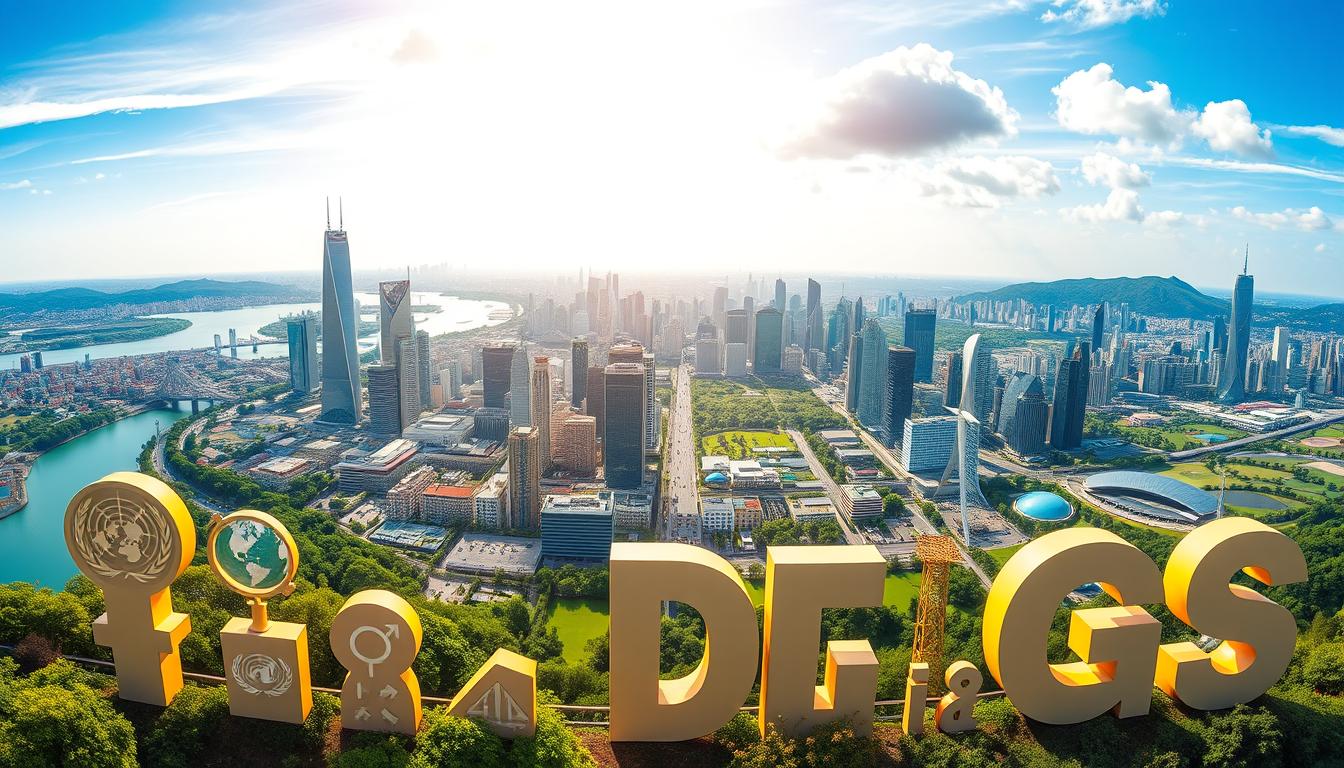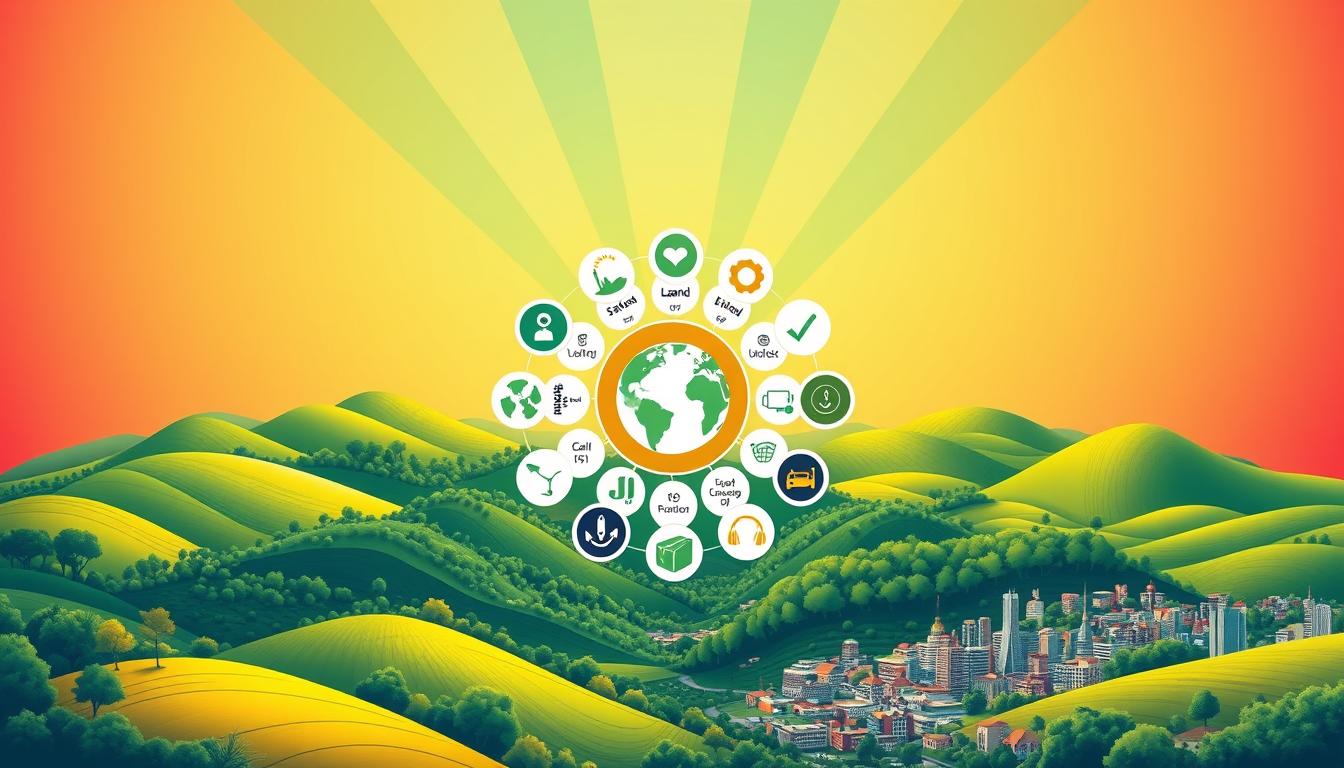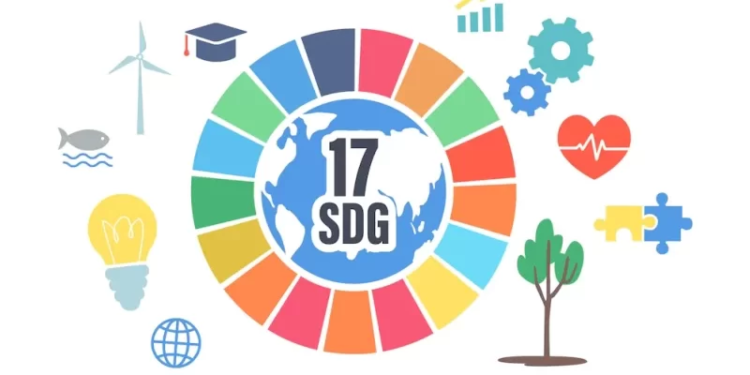Can a global plan truly lift millions out of poverty while protecting the planet and boosting prosperity? That question sits at the heart of the 2030 Agenda and guides how nations, businesses, and communities act today.
The sustainable development goals are a universal framework adopted by the United Nations in 2015. They translate 17 targets into concrete measures that governments, civil society, and firms can use to improve lives and reduce inequality.
The path to adoption started decades earlier, from Agenda 21 to the Millennium Development Goals. The General Assembly and the UN Sustainable Development Summit set the stage for member states to align policy, investment, and programs.
Progress is tracked through an annual SDG report and a global indicator framework. This data-driven approach helps U.S. cities, agencies, and companies turn high-level goals into clear action with measurable results.

Key Takeaways
- The 17-goal framework offers a practical blueprint for policy and business action through 2030.
- Adoption in 2015 built on past global efforts and UN deliberations.
- Annual progress reports and indicators enable accountability and course correction.
- Climate, biodiversity, and equality are woven across the targets to reduce trade-offs.
- U.S. organizations can tap global partnership platforms to scale solutions.
What the Sustainable Development Goals Mean for the 2030 Agenda in the United States
The 2030 agenda offers a common blueprint that U.S. institutions use to shape budgets, policies, and partnerships. Adopted unanimously by the United Nations member states in 2015, the agenda frames 17 global targets that federal and local actors translate into action.
The general assembly endorsement set the stage for U.S. engagement across agencies, states, cities, tribes, and territories. Federal programs now map priorities to the global indicator framework and use national statistical systems to report progress.
The High-level Political Forum on Sustainable Development is the primary forum sustainable development for follow-up and review. The Secretary-General’s annual SDG Progress Report relies on open data and national case studies to assess implementation.
U.S. companies align material risks—climate, water, labor, and supply chain—with the 17 goals through ESG strategies and KPIs tied to the global indicators. Local governments apply the agenda in transit planning, resilience hubs, and equitable housing to drive inclusive economic growth.
Strong governance, a coordinated global partnership, and clear terminology help maintain comparability and credibility. Preparing for HLPF engagement means aligning reporting cycles, curating case studies, and sharing open data to support evidence-based implementation and lasting peace.

Objectives and Targets across the 17 Sustainable Development Goals
Clear targets translate global aims into local action that improves access, jobs, and resilience. This section groups related targets so planners and managers can align programs with measurable outcomes.

Ending poverty and hunger
Goal 1 and Goal 2 focus on expanding social protection floors and securing year-round access to nutritious food. Programs scale climate-resilient agriculture to support smallholders and strengthen rural livelihoods.
Health and education for all
Goals 3 and 4 target maternal and child health, NCD reduction, and universal health coverage. Education aims for inclusive, quality learning that builds digital skills and lifelong opportunity.
Equality, water, energy, and jobs
Goals 5 and 10 remove barriers for women and reduce income gaps. Goals 6 and 7 ensure safe water, sanitation, and reliable modern energy. Goals 8 and 9 promote decent employment, sustained growth, and resilient infrastructure.
Cities, nature, justice, and partnership
Goals 11–13 shift cities and production toward circular models and climate action. Goals 14–15 protect oceans and forests. Goal 16 builds accountable institutions. Goal 17 mobilizes finance, data, and technology to scale solutions worldwide.
Practical mapping aligns organizational initiatives with the most material targets, turning objectives into KPIs tied to access, learning, employment, and improved lives.
Sustainable Development Goals Implementation Services: Data, Standards, and Reporting
Effective services combine standards, data architecture, and stakeholder engagement to drive verified progress. This practical setup helps U.S. agencies and firms turn commitments under the 2030 agenda into audited performance.
Using ISO/UNDP PAS 53002:2024 to operationalize SDG commitments
ISO/UNDP PAS 53002:2024 provides a governance blueprint for embedding targets into risk and performance systems. Use it to map materiality, set time-bound targets, and create assurance steps that link strategy to execution.
Indicators and measurement
Build a measurement architecture that aligns KPIs with the UN global indicator framework. Define metadata, baselines, and disaggregation to produce decision-grade data and comparability across reporting periods.
Progress reporting and the High-level Political Forum
Synchronize internal reviews with the Secretary-General’s SDG Progress Report and HLPF timelines. A clear reporting cadence supports transparent disclosures and stakeholder dialogue grounded in recognized norms.
Building a global partnership and resourcing
Design a stakeholder model that links suppliers, communities, investors, and agencies. Align governance sponsorship, budget, tech stacks, and capacity-building so teams can deliver targets and promote inclusive sustainable impact.
Service workflow — SDG mapping, KPI selection, data architecture, reporting, and HLPF readiness — plus ISO management standards (e.g., ISO 14001, ISO 45001) drive continuous improvement and economic growth.
Advancing Gender Equality across all Sustainable Development Goals
Centering women and girls in policy and planning unlocks measurable gains across health, economy, and climate action. UN Women’s “Gender snapshot” series and the report “Turning promises into action” show that gender equality underpins success across the 17 goals and that COVID-19 reversed many gains.
Integrating the UN Women “gender snapshot” insights into strategy, data, and action
Use disaggregated KPIs and intersectional metrics to reveal who is left behind. Set targets from evidence in the snapshot reports and track recovery measures that expand care infrastructure, safe work, and inclusive finance.
Mainstream gender across procurement, pay, parental leave, and leadership pipelines. Embed prevention of gender-based violence, access to justice, and survivor-centered services into policy and monitoring.
Link gender-responsive budgeting to health, education, water, and energy investments so outcomes for women and girls are measurable. Engage community leaders and partners—UN Women, NGOs, and universities—to scale evidence-based solutions that build peaceful inclusive societies.
Conclusion
Real change comes when organizations embed the 2030 agenda into daily decision-making and performance systems. The sustainable development goals serve as a universal call to action, backed by annual HLPF reviews and the global indicator framework.
Align strategy, data, and reporting to build credibility and speed measurable progress. Use standards such as ISO/UNDP PAS 53002:2024 to institutionalize continuous improvement and manage risks tied to climate change, justice, and security.
Act now: make targets part of planning, capital allocation, and risk management. Foster a global partnership sustainable platform to mobilize finance, technology, and talent that promote sustainable innovation, decent jobs, and durable economic growth.
Transparent disclosures let stakeholders see results, support what works, and help shape a more resilient world where no one is left behind.
FAQ
What are the main objectives and targets under the Sustainable Development Goals?
The SDGs set 17 broad objectives that cover poverty eradication, health, education, gender equality, clean water and energy, decent work, industry, cities, climate action, life below water, life on land, peace and justice, and global partnerships. Each goal breaks down into specific targets and indicators that guide policy, funding, and action at global and national levels.
How does the 2030 Agenda apply to the United States?
The 2030 Agenda serves as a global blueprint that U.S. federal, state, local governments, nonprofits, and businesses can adapt. It shapes policy choices on economic growth, social inclusion, and climate resilience, and it encourages data-driven progress reporting aligned with the UN General Assembly outcomes and the High-level Political Forum.
What role do U.S. organizations play in implementing the 2030 Agenda?
U.S. universities, NGOs, corporations, and local governments align programs and investments to targets such as ending poverty, expanding access to health and education, promoting gender equality, and reducing emissions. Many adopt standards, publish SDG-aligned reports, and partner internationally to scale solutions.
How do Goals 1 and 2 tackle poverty and hunger?
Goals 1 and 2 focus on access to income support, social protection, nutritious food, and resilient agriculture. Targets emphasize reducing extreme poverty, eliminating hunger and malnutrition, supporting smallholder farmers, and strengthening food systems against shocks like climate change.
What are the pathways for health and education under Goals 3 and 4?
Goals 3 and 4 prioritize universal access to quality health care, maternal and child health, vaccines, mental health, and lifelong learning. Strategies include strengthening primary care, investing in schools and teachers, and using data to reach underserved communities.
How do Goal 5 and Goal 10 accelerate gender equality and reduced inequalities?
Goal 5 aims to end discrimination and violence against women and girls, ensure equal access to education, work, and leadership. Goal 10 focuses on reducing income and social disparities. Together they promote laws, policies, and public investments that expand opportunity and justice for marginalized groups.
What targets address water and energy (Goals 6 and 7)?
These targets aim for universal access to safe drinking water and sanitation, sustainable water management, and affordable, reliable, and clean energy. Emphasis lies on infrastructure, efficiency, renewable sources, and resilience to climate impacts.
How do Goals 8 and 9 promote jobs, industry, and innovation?
Goals 8 and 9 support decent work, inclusive economic growth, industrial diversification, and resilient infrastructure. Policies encourage entrepreneurship, vocational training, technology adoption, and sustainable industrial practices to boost productivity and employment.
What do Goals 11, 12, and 13 say about cities, consumption, and climate?
These goals push for inclusive, safe, and resilient cities, sustainable consumption and production patterns, and urgent climate action. Measures include efficient public transit, waste reduction, circular economy policies, and national commitments to reduce greenhouse gas emissions.
How are oceans, forests, and biodiversity protected under Goals 14 and 15?
Goal 14 targets conservation and sustainable use of marine resources, while Goal 15 focuses on terrestrial ecosystems, forests, and biodiversity. Actions include marine protected areas, reforestation, habitat restoration, and combating illegal wildlife trade.
What does Goal 16 mean for peace, justice, and institutions?
Goal 16 promotes peaceful, inclusive societies, access to justice, and accountable institutions. Targets cover reducing violence, strengthening rule of law, combating corruption, and ensuring transparent decision-making at all levels.
How does Goal 17 support implementation through partnerships?
Goal 17 focuses on finance, technology transfer, capacity building, and data to scale action. It encourages international cooperation, private sector engagement, and stronger national statistical systems to track progress.
What standards and services help operationalize SDG commitments?
Organizations use standards such as ISO frameworks and guidance like UNDP tools to align policies and reporting. Services include indicator mapping, data collection systems, third-party assurance, and strategic planning to meet targets and improve transparency.
How are indicators and measurements managed globally?
The global indicator framework, managed by the UN and national statistical offices, provides specific metrics for each target. Countries adapt indicators to national contexts, submit data to the UN SDG database, and report progress at the High-level Political Forum.
What is the role of the High-level Political Forum in progress reporting?
The High-level Political Forum reviews voluntary national reports, facilitates peer learning, and highlights gaps and best practices. It helps drive political attention, coordinate multistakeholder action, and steer global efforts toward the 2030 timeline.
How can organizations build effective global partnerships?
Effective partnerships bring governments, civil society, the private sector, and academia together. They focus on shared objectives, pooled resources, transparent governance, measurable results, and continuous improvement to scale impact.
How do gender data and the UN Women “gender snapshot” inform action?
Gender-focused data identify gaps in access, participation, and outcomes for women and girls. The UN Women snapshot provides evidence to design targeted policies, track progress across sectors, and ensure gender-responsive budgeting and programming.
How does climate change intersect with all goals?
Climate change affects health, food security, water, cities, and livelihoods. Integrating climate resilience into policies and investments strengthens outcomes across all targets and reduces long-term risks to people and ecosystems.
Where can stakeholders access resources and finance for implementation?
Resources come from domestic budgets, multilateral development banks, philanthropic funds, and private investment. Goal 17 mechanisms, national plans, and donor platforms help match funding to priority programs and data-driven projects.





